Providing the basic necessities:
Fortunately for those who have little space to spare (which means most people), the necessities of sewing are actually very few, and can be accommodated in a relatively small area. The units illustrated are doubly space-saving be cause they all serve more than one sewing purpose. And when they are closed, their sewing functions are concealed, and they become hand some additions to their surroundings.
Each represents a type of convenience that is nationally available, as shown or in forms very similar.
To function efficiently, of course, the facilities that are provided must meet, or closely approximate, quite specific criteria.
Machine operation---The cabinet or other operating unit should be strong and steady, about 30 inches high, approximately 18 to 20 inches from front to back and 35 to 40 inches wide- enough space for machine and fabric. Though a machine can simply rest on the surface, the ideal situation is like the one below, in which a recessed area is provided that exactly fits the base. If the cabinet also provides for machine storage, as this one does, so much the better. In the unit to its right, the machine fits conveniently on the lower shelf, and is concealed by the fold-down table when it is raised.
Fabric cutting and handling calls for a surface about 3 by 6 feet. If a working unit is built of components, like the one at the far right, the top can be made large enough for cutting. If a smaller surface must be used-or one not meant for cutting, such as a dining table or a bed-a cutting board is advisable. Besides providing efficiently for measuring, pinning, and cutting, the board will protect the surface beneath.
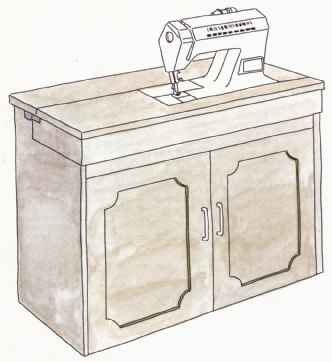
----Cabinet of many purposes makes a place, in only 21 by 42 inches of
floor space, for both machine operation and storage, and for sewing necessities
of many kinds. Designed by a sewing machine company for use with its free arm
convertible models (and available at present only for machines of that type),
the cabinet features an exclusive swing-away surface that accommodates both
operating modes: up for flat bed; down and away for free arm.
Specialized storage --- The important considerations here are appropriateness and accessibility. Broad shelves or shallow drawers are best for fabrics; patterns stay in better shape and are easiest to select if they are fi1ed" on end, with pattern numbers on top. Threads require spool holders, either built-in as in the cabinet, or the portable type that can be kept in a drawer or sewing box. Cutting and other sharp tools should be stored as you would good cutlery- so blades or points are protected, and you can reach what you need without risk or difficulty. Small items need organizing in a partitioned drawer or tray. Clear plastic units, preferably those that work like drawers, make it possible to see what is stored so you can pull out zippers or seam tapes without rummaging through the whole collection. If possible, separate books with vertical dividers.
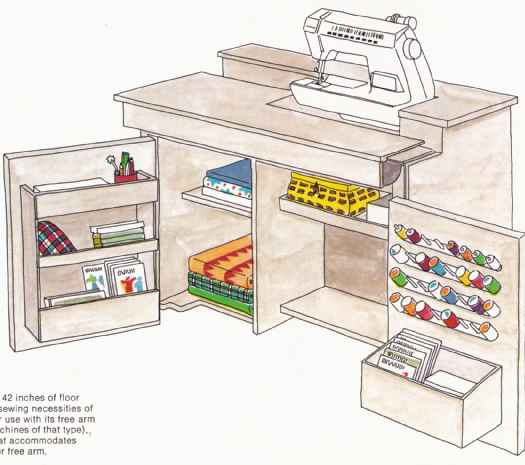
Pressing equipment --- Because pressing is important at every sewing stage, it is best if the board, iron, and special-purpose equipment are housed in or very near the sewing area. This is usually a question of available space; sometimes a closet can be partitioned to take the board and one of its shelves set aside for the rest. If the board must be kept else where, look into the small portables you can set up on another surface.
Full-length mirror --- Useful when taking measurements and at all fitting stages, a satisfactory mirror need not be expensive. Least conspicuous place for it: behind a closet door.
Dress form. To be truly useful, a dress form should be available for instant use. Check adjacent closets.
Lighting --- Take advantage of natural daylight. Plan artificial light so that working areas are generously illuminated and shadow-free.
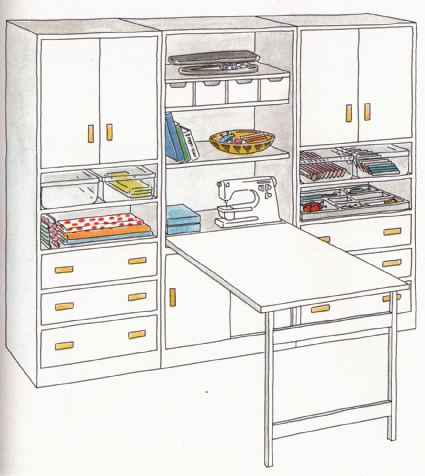
----Fold-down table equips this storage unit for machine operation. Niche
at far end of table houses machine when it is not in use; table folds back
up to conceal it. Storage shelves above and cabinet below take a variety of
tools and supplies. Units of this type are sometimes part of a modular system,
as shown, but can usually be purchased separately. Well made, with handsome
white enamel or wood grain finishes, they would be decorative assets anywhere
in the house. When units are closed, no one would guess that they are anything
but attractive pie of furniture.
Work table of components is just one example of the many possibilities offered by combinations of separate parts. The top could be a flush door, a plastic-laminated slab, a rectangle of plywood; it could also be purchased large enough for cutting, unlike the two examples at the left. The storage units could also vary: both sides instead of one; stacked cubes as shown, a desk-type pedestal, or a modular base unit, perhaps bought unfinished and painted yourself. Legs, if they are used, should be well braced for steadiness.
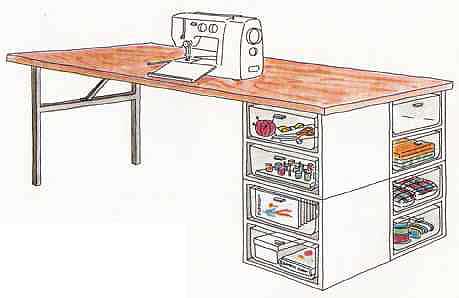
+++++++++++++++++
Suiting storage to your needs
Sometimes supplementary storage is all a sewing area needs to function more efficiently. A practical solution is modular units based on the cube, and usually made of plastic, which can be chosen and arranged to suit your needs. Not all systems offer the same variations, but among the frequent possibilities are cubes with dividers that can be used horizontally or vertically; with drawers of different depths; with hinged doors.
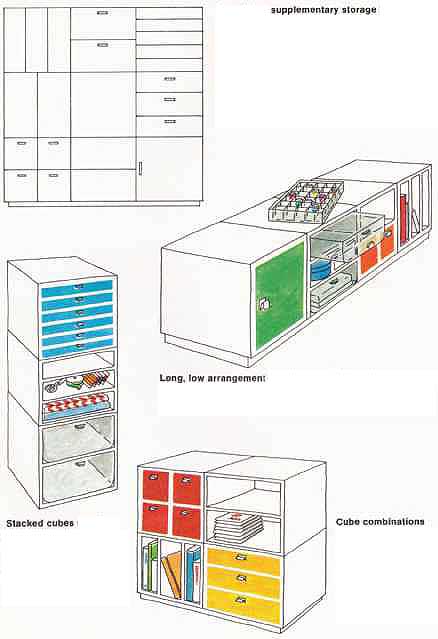
Stacked cubes supply flat shelving for fabrics, drawers in two depths. Shallow ones are excellent for keeping small items separate and accessible.
Long, low arrangement provides bin, shelf, and drawer storage, stand-up slots for books or patterns. Tops make a convenient surface for sorting and selecting.
Cube combinations: can be stacked to any desired height. If grouping will be free standing, look for system that provides clips, pegs, or other means of holding the cubes together.
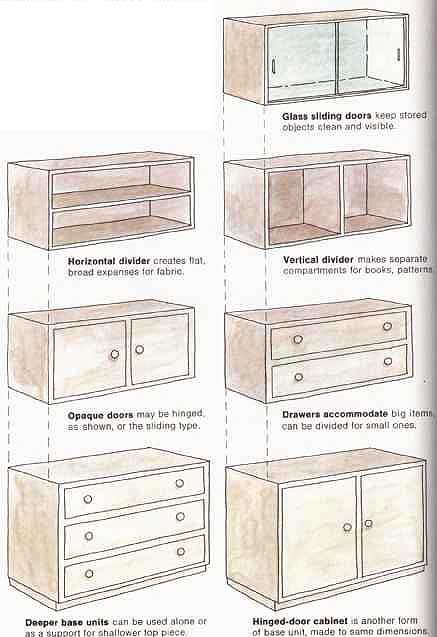
----- Unfinished furniture suppliers usually carry extensive lines of
storage units, made to related heights, depths, and widths, that can be arranged
in combinations like those on the left. The usual stacking procedure is shallower
top units on deeper bases, similar in effect to a hutch cabinet. Though this
method need not be followed, it is advisable, because it avoids the risk of
the unit becoming dangerously top-heavy.
Deeper base units can be used alone or as a support for shallower top piece.
Hinged-door cabinet is another form of base unit, made to same dimensions,
